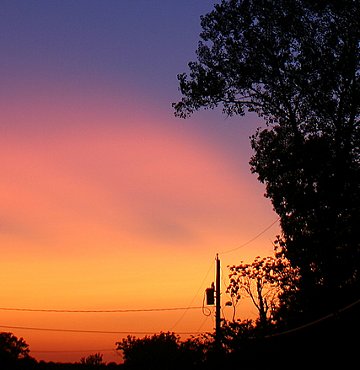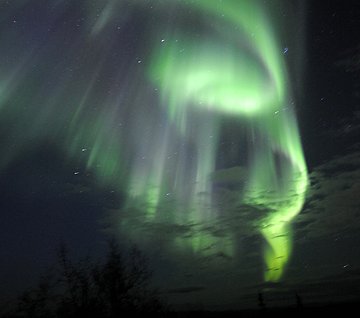| JULES VERNE UNDOCKS: The European Space Agency's robotic cargo carrier, Jules Verne, undocked from the ISS on Sept. 5th. Now the two spacecraft are flying through the night sky in tandem. Michel Vandeputte saw them soaring over Ronse, Belgium, on Sept. 6th: "The Jules Verne was visible at magnitude 0; the ISS at magnitude -2." Readers, check the Satellite Tracker for flybys of your hometown. 3D BONUS: Put on your 3D glasses and check out Jules Verne, docked in stereo: #1, #2. Graphic artist Patrick Vantuyne of Belgium created the anaglyphs from photos taken by shuttle astronauts in June 2008. RELENTLESS KASATOCHI: Nearly a month after the eruption of Alaska's Kasatochi volcano, the volcanic sunsets continue. Doug Zubenel of De Soto, Kansas, sends this snapshot taken at the end of the day on Sept. 4th: 
"A cold front moved through our area during the past 24 hrs, leaving very clear skies at sunset," says Zubenel. "The aerosols from Kasatochi, however, were in great evidence, painting the twilight sky pink and orange!" The message: Get used to it. Kasatochi's stratospheric ash cloud has circumnavigated the northern hemisphere and might not disperse for months. When the sun goes down (or comes up) look for subtle pink waves, dramatic purple rays and campfire-red horizons. They won't appear every day, but even a single visit from Kasatochi can be unforgettable. more images: from Jim Werle of Las Vegas, Nevada; from Jeff Hapeman flying 11,000m over southern Greenland; from Gary Honis at the Chery Springs Dark Sky Park in Cherry Springs, Pennsylvania; from Mark E. Peter of Highland County, Ohio; from Hugh Helmick of Inyokern, CA; from Tadd Parris of Minneapolis, Minnesota AURORA WATCH: This morning (Sept. 6th) in Alaska, "the whole sky lit up with strong auroras directly overhead," reports Lance Parish who sends this photo from Skiland, not far from Fairbanks:  The source of the display was a solar wind stream, now buffeting Earth's magnetic field for the third day in a row. NOAA forecasters estimate a 15% chance of continued geomagnetic activity tonight. Sky watchers in Alaska, Canada and Scandinavia should remain alert for auroras. September 2008 Aurora Gallery
[Past Septembers: 2007, 2006, 2005, 2004, 2002, 2001] | 
